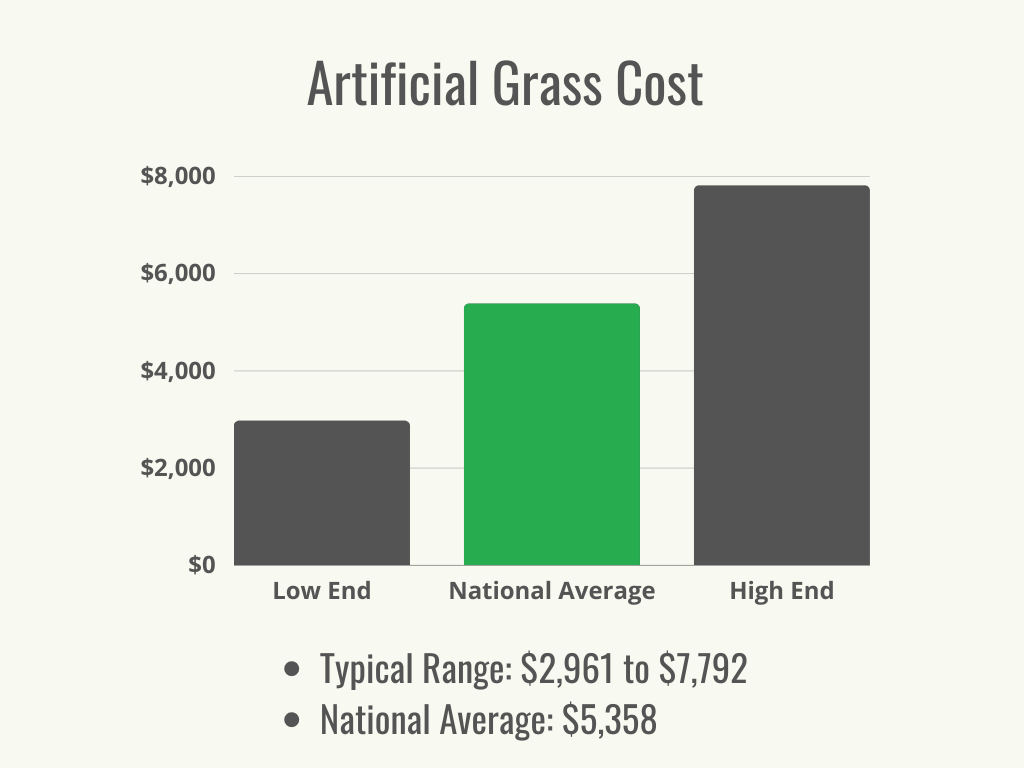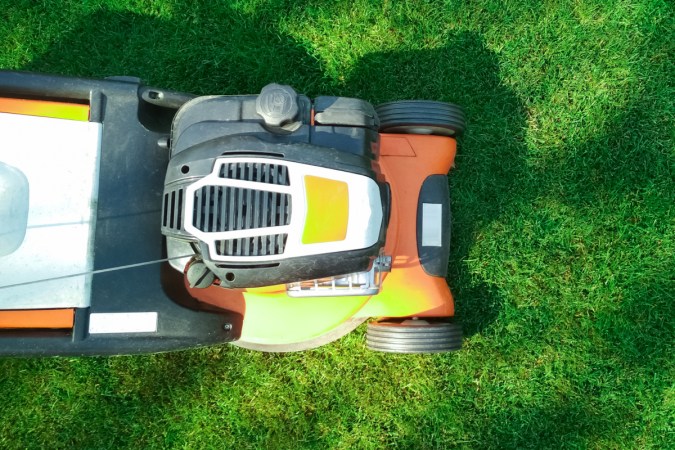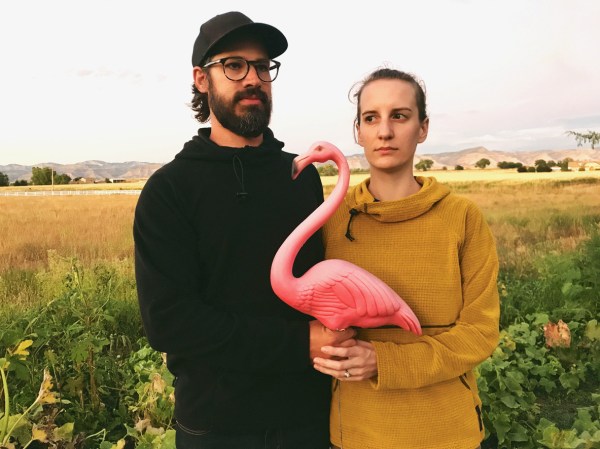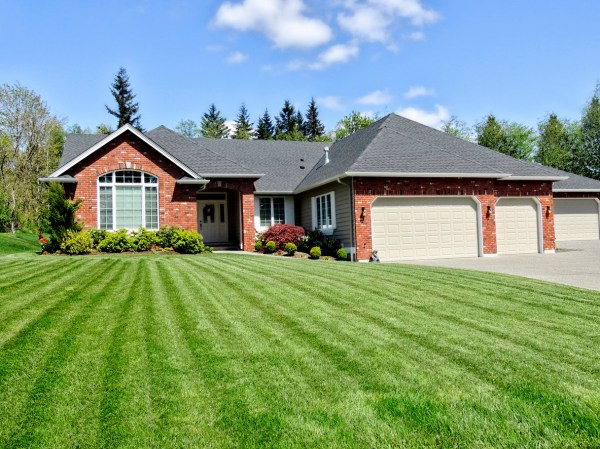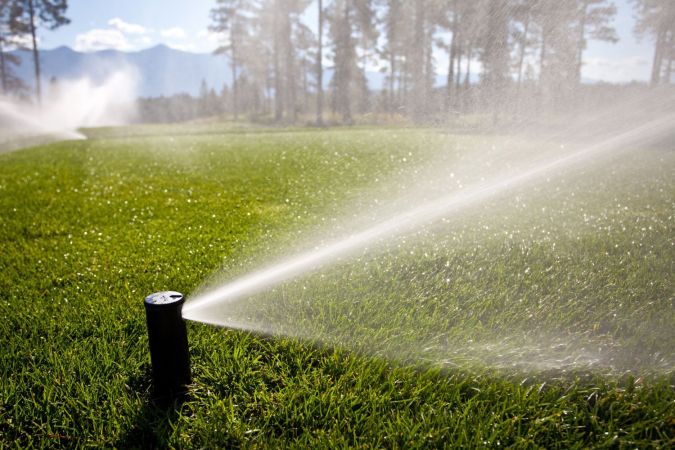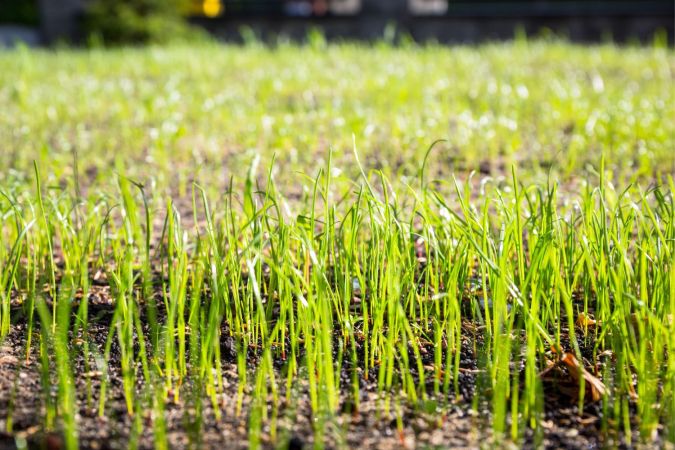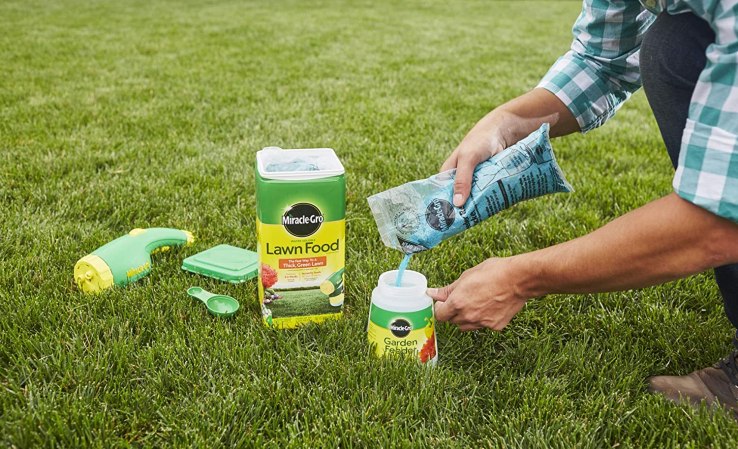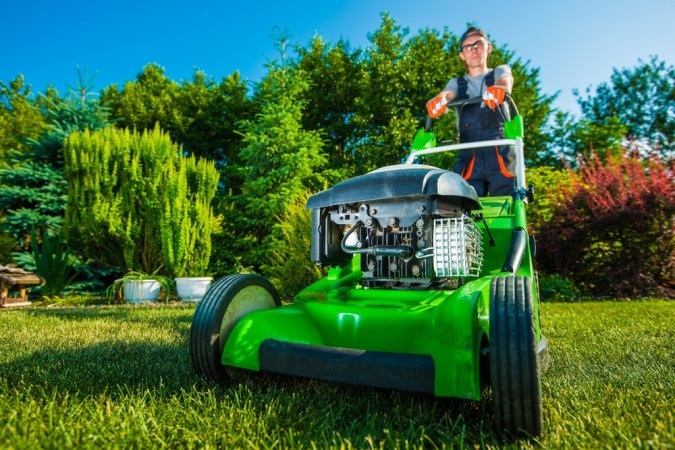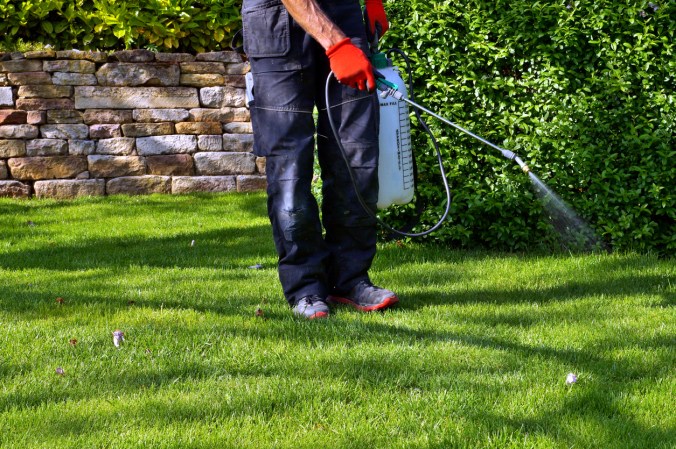We may earn revenue from the products available on this page and participate in affiliate programs. Learn More ›
Highlights
- The typical range for artificial grass costs is $2,961 to $7,792, with a national average of $5,358.
- Yard size and shape, turf material and brand, labor, installation location, blade shape, base material, weed barrier, irrigation, preparation and cleanup, and geographic location can all affect how much a homeowner pays for artificial grass.
- Benefits of artificial grass installation include pest, weed, disease, and drought resistance; sustainability; reduced maintenance; improved drainage; cost effectiveness; child friendliness; and improved curb appeal.
- Artificial grass installation is best left to experienced professionals as errors can result in drainage issues, mold, and mildew growth.
Artificial grass is a growing trend among homeowners. The lure of artificial turf includes reduced water costs; better drainage; minimized maintenance; a stunning appearance in both sunny and shaded areas; and not exposing family and pets to pesticides, fertilizers, and chemicals. Today’s artificial grass looks more realistic than ever, but incorrect installation can make it look fake and unnatural. A professional artificial grass installer has the experience, skill, and specialized tools to make the fake grass look more realistic.
How much does artificial grass cost? According to Angi and HomeAdvisor, the cost of artificial grass ranges from $2,961 to $7,792, with the national average at $5,358 for materials and installation. The overall artificial grass cost depends on how much artificial turf is needed and the type of artificial grass. Installed correctly, artificial grass can last 20 years or more. It’s child- and pet-friendly, and high-quality artificial grasses resist warping and stretching and are comparable to the temperature of natural grass in hot conditions. Today’s artificial grass is composed of a range of green hues to provide a more natural appearance. Some types of faux grass even have a thatch layer to make them look more true to life.
With a price between $2 and $8 per square foot, the cost to install artificial grass is higher than the cost to install sod, which runs between $0.90 and $2 per square foot. Despite the up-front costs of artificial grass, homeowners can save time, energy, and money on water, fertilizer, chemicals, and pesticides that traditional lawns need. A professional landscaper typically charges between $3 and $12 per square foot for labor to install artificial grass, depending on the difficulty of the job and the size of the yard. This guide will examine the additional costs and considerations that impact artificial turf cost, the different types of artificial grass, the benefits of installing fake grass, and important questions for a homeowner to ask an artificial grass installation company.
Factors in Calculating Artificial Grass Cost
How much is artificial grass? That depends on several factors. Prices can differ from the national average due to yard size and shape, turf material, turf brand, labor prices, installation location, grass blade shape, base material, weed barrier, irrigation, site preparation, cleanup, and geographic location. Some websites have a helpful artificial grass cost calculator that homeowners can use to estimate their installation costs. Homeowners can more easily set a budget for this project if they can get a better idea regarding what affects artificial turf grass cost.
Yard Size and Shape
Synthetic grass runs between $2 and $8 per square foot, depending on the type and brand. Some stores sell artificial grass by the roll or by the linear foot, and some places may custom cut the turf to size. Rolls of artificial grass typically come in widths between 7 and 15 feet. Larger areas will require more material, which will increase the overall cost of the project.
Cutting the artificial grass to fit an unusually shaped area can add to the overall cost. Curved designs or cutting the grass for areas that are not square or rectangular can increase the labor costs by $1 to $3 or more.
| Yard Size | Average Cost |
| 50 square feet | $100 to $400 |
| 100 square feet | $200 to $800 |
| 200 square feet | $400 to $1,600 |
| 500 square feet | $1,000 to $4,000 |
| 1,000 square feet | $2,000 to $8,000 |
| 5,000 square feet | $10,000 to $40,000 |
| 10,000 square feet | $20,000 to $80,000 |
Turf Material
Artificial grass is made from nylon, polypropylene, or polyethylene. The cost of artificial turf will depend in part on which of these materials is chosen. Each material has unique features and qualities that may work better for specific locations or needs. For instance, nylon is one of the more durable materials, whereas polypropylene has a more attractive and natural look. Each type of turf material is discussed in more detail in a section below.
Turf Brand
The best artificial grass lets homeowners, their family, and their friends enjoy the backyard, and they won’t have to worry about lawn care and maintenance. When deciding on artificial turf, there are several brands for homeowners to choose from at varying quality and pricing levels. The following table lists some of the most common artificial grass brands and their average prices per square foot.
| Brand | Cost per Square Foot |
|---|---|
| Onelawn | $2.30 to $7.30 |
| PreGra | $2.60 to $3.67 |
| Perfect Turf | $4 to $5 |
| K9Grass | $4.50 to $9.50 |
| ForeverLawn | $4.50 to $9.50 |
| ProGreen | $4.50 to $11.50 |
| SYNLawn | $5.50 to $7.50 |
Labor
Labor for turf installation costs $3 to $9 per square foot, depending on the type of synthetic turf, the size of the area, and the amount of prep work. Homeowners will want to keep in mind that labor costs are usually more expensive in densely populated urban areas than in more rural locations. Labor costs will also be higher if the area where the turf is to be installed is uneven, as the installer may need to level the yard in order to get a good fit.
Installation Location
Before artificial grass can be installed, the area needs to be prepped. This involves removing rocks and tree stumps, excavating, and resurfacing the area. If the location is difficult to access or if the space needs extensive clearing, it will result in higher labor costs. Sometimes homeowners will choose to have fake grass installed in unusual areas, such as on stairways, rooftops, decks, patios, concrete surfaces, walls, indoors, or in child or pet play areas. These locations can affect the fake grass cost since they require special adhesive and additional treatment to prevent mold and mildew growth.
Blade Shape
Artificial turf grass comes with a variety of blade shapes to make the turf look more realistic. In the early days of synthetic grass manufacturing, the grass had a more carpet-like look instead of resembling a real lawn. Today’s artificial grass blades come in varying lengths of 2 or 4 inches to add to a more natural look. What follows are the different blade shapes and their characteristics.
- C-shaped grass blades. C-shaped blades are long lasting, durable, and have an upright shape.
- M-shaped grass blades. These are possibly the most realistic-looking artificial grass blades.
- S-shaped grass blades. S-shaped blades are also realistic looking and are soft underfoot, but they are not as durable or heat-resistant.
- U-shaped grass blades. These synthetic blades are long lasting, durable, and soft.
- V-shaped grass blades. V-shaped blades are well suited for high-traffic areas, and they have a fast recovery time.
- W-shaped grass blades. Natural-looking W-shaped blades are the most heat-resistant, durable, and long lasting of the artificial grass blades.
Base Material
For easy-draining artificial grass, the base material needs to be laid down before the turf. The base material consists of crushed rock or decomposed granite and landscaping fabric to prevent weed growth. The crushed rock and decomposed granite costs from $0.30 to $0.70 per square foot, and the landscaping fabric runs from $0.40 to $0.80 per square foot.
Infill is an important part of artificial grass installation. Applied after the artificial turf, infill consists of sand or rubber that supports the faux grass blades, keeps them upright, weighs down the artificial grass, and extends the life of the artificial lawn. Some types of infill are treated with an antimicrobial coating that helps prevent bacteria growth and eliminate pet waste odors. Infill also supplies a soft layer underfoot so the artificial grass feels more natural and lifelike. Infill is commonly applied with a spreader on top of the artificial grass to ensure even application. A push broom is used to spread the infill and make sure it drops down to the base of the artificial lawn. Without infill, the artificial lawn will lack the natural feel and look of a conventional lawn.
Weed Barrier
A weed barrier prevents weed growth in the artificial grass. A roll of weed barrier fabric usually covers about 1,500 feet and costs approximately $90. While it is possible for weeds to grow in artificial grass, there is significantly less growth than with a conventional lawn.
Irrigation
To ensure proper water runoff, limestone chips or decomposed granite will need to be installed. Decomposed granite costs between $0.30 and $0.70 per square foot. In some cases, a drainage system will also need to be installed for the artificial grass. This can cost anywhere from $100 to $2,000 depending on the type of system that is installed.
Preparation and Cleanup
Before the artificial grass can be installed, the area needs to be prepared. Most areas need to be excavated and smoothed out before the synthetic grass can be laid down. The prep work involves the removal of tree stumps, rocks, sticks, leaves, and debris. The existing grass is removed and the entire area is excavated to a depth of 2 inches, which runs from $50 to $200 per cubic yard. A weed barrier is installed, crushed rocks are added and tamped down to create an even surface, and then sand is poured over the rocks to remove any bumps.
Sod and dirt removal can cost between $8 and $25 per cubic yard. Dirt recycling is another option that costs from $30 to $120 per ton. In total, it costs an average of $325 for a landscaper to remove grass and debris and dispose of it at a local dump, or around $575 for them to remove the materials and recycle them.
Geographic Location
Material and labor costs vary according to geographic location. Artificial grass prices in a densely populated urban area are typically more expensive than in suburban or rural locations. Boston is one of the pricier locations for installing artificial grass at $7,200 on average. On the other hand, homeowners in Detroit only pay around $4,500.
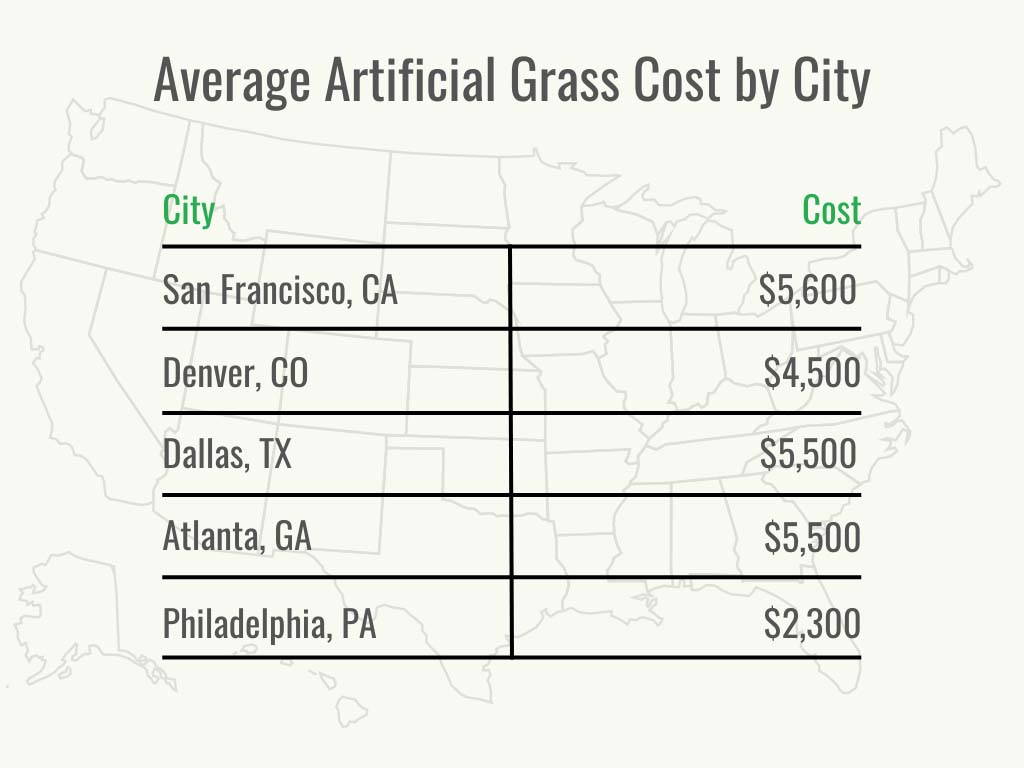
Additional Costs and Considerations
When answering the question of “How much does turf cost?” it’s important for homeowners to know about any additional costs and considerations that can add to the overall price. These can include debris removal, additional landscaping, and maintenance.
Debris Removal
After excavation, the dirt, grass, landscaping, rocks, tree stumps, and any concrete needs to be removed. Some pros may include the price of removal with their labor costs, but others will add a separate charge to their estimate for debris removal. Homeowners will want to check with the artificial grass installation company regarding their removal policies and pricing.
Additional Landscaping
The landscaping around the newly installed artificial grass may need some changes. If a homeowner has been looking at artificial turf landscaping ideas and wants new flower beds, trees, mulch, or shrubs installed, it will add a significant amount to the overall price of the installation project. On the other hand, scheduling all of these services at the same time will often result in a homeowner paying a lower overall price than if they were charged as separate projects.
Maintenance
While an artificial grass yard will not require homeowners to pay for fertilizer or lawn mowing costs, it still requires some upkeep. If pets use the artificial turf, it will need regular rinsing, cleaning, and deodorizing to keep unpleasant odors at bay. If weeds make their way through a weed barrier, pulling weeds or spraying to prevent growth will need to be done about twice a year. Removal of dirt and debris can be done by using a power washer or rinsing with a hose and using a stiff-bristled broom. A broom can also be used to correct artificial grass blades that are matted down. Raking to remove leaves, twigs, and debris is recommended to keep the artificial grass looking its best.
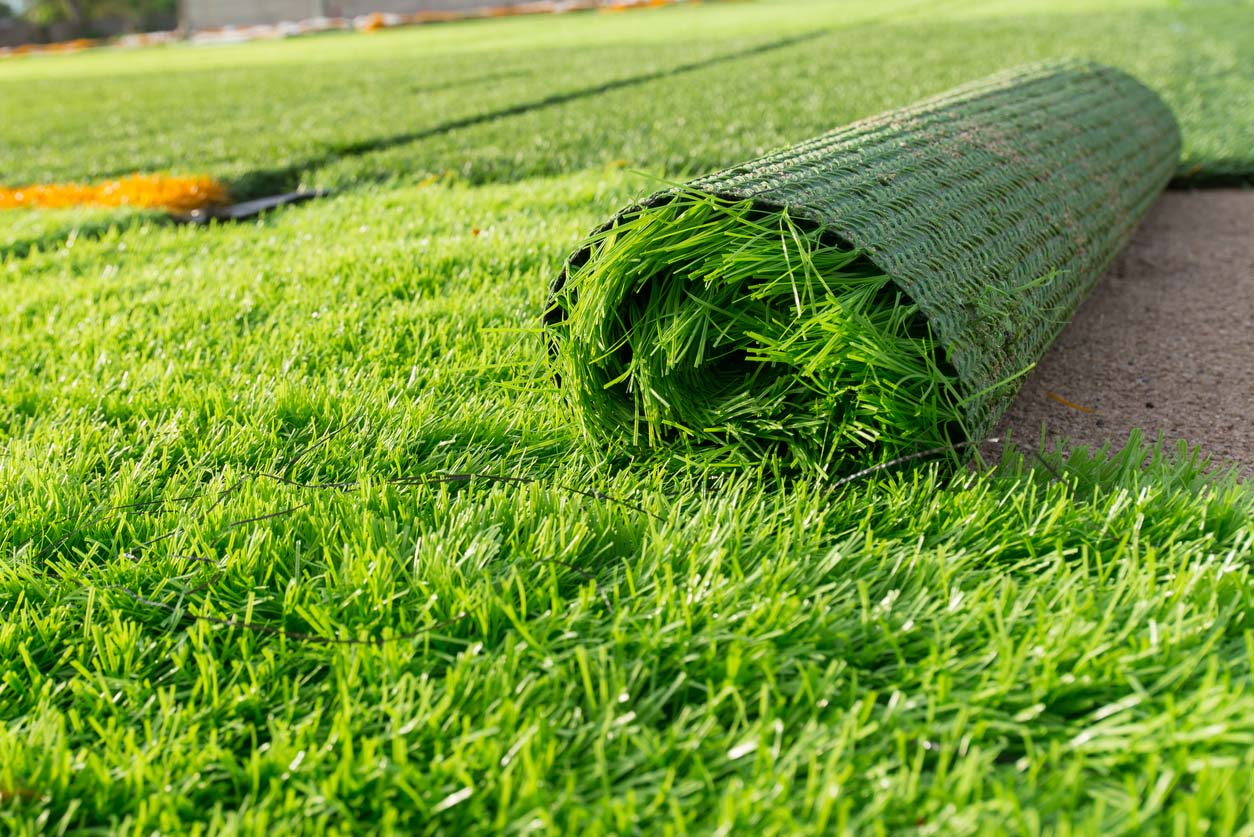
Types of Artificial Grass
How much is turf? That depends on the type of artificial turf that’s installed. There are three main types of artificial grass, and each one has its own unique characteristics, benefits, and price ranges.
Artificial grass is made of synthetic fibers that mimic the look and feel of natural grass. The nonabrasive and nontoxic materials are made into green blades, called yarns, that resemble the flexible and soft blades of real grass. The artificial grass fibers are treated with UV inhibitors to resist fading from the sun to look green and lush, even during the worst drought conditions. The artificial grass yarns are stabilized to prevent the fake grass from collapsing and compacting under the weight of foot traffic. The following are the three types of artificial grass and their average cost per square foot.
| Artificial Grass Type | Cost per Square Foot |
| Nylon | $5 to $6 |
| Polypropylene | $2 to $6 |
| Polyethylene | $2 to $4 |
Nylon
Nylon artificial grass is extremely durable and will keep its shape even under heavy foot traffic and weight. It has a stiff pile that holds up in blistering temperatures and has a natural look. Some homeowners opt for this type of artificial turf if they live in a hot climate or want to use part of their lawn for a putting green. The cost of nylon artificial grass ranges from $5 to $6 or more per square foot.
Polypropylene
Polypropylene grass has a soft, natural texture, and high-end options can be very durable. The lower-end options are typically not well suited for heavy foot traffic or hot temperatures. This type of artificial grass works well in low-traffic, shady areas and costs about $2 to $6 per square foot.
Polyethylene
The least durable of the three artificial grass options, polyethylene grass is also the least expensive at $2 to $4 per square foot. This is an excellent option for budget-conscious homeowners who are interested in an artificial grass lawn. Homeowners will want to keep in mind that this type of artificial turf is not well suited to high foot traffic or extended periods of high temperatures.
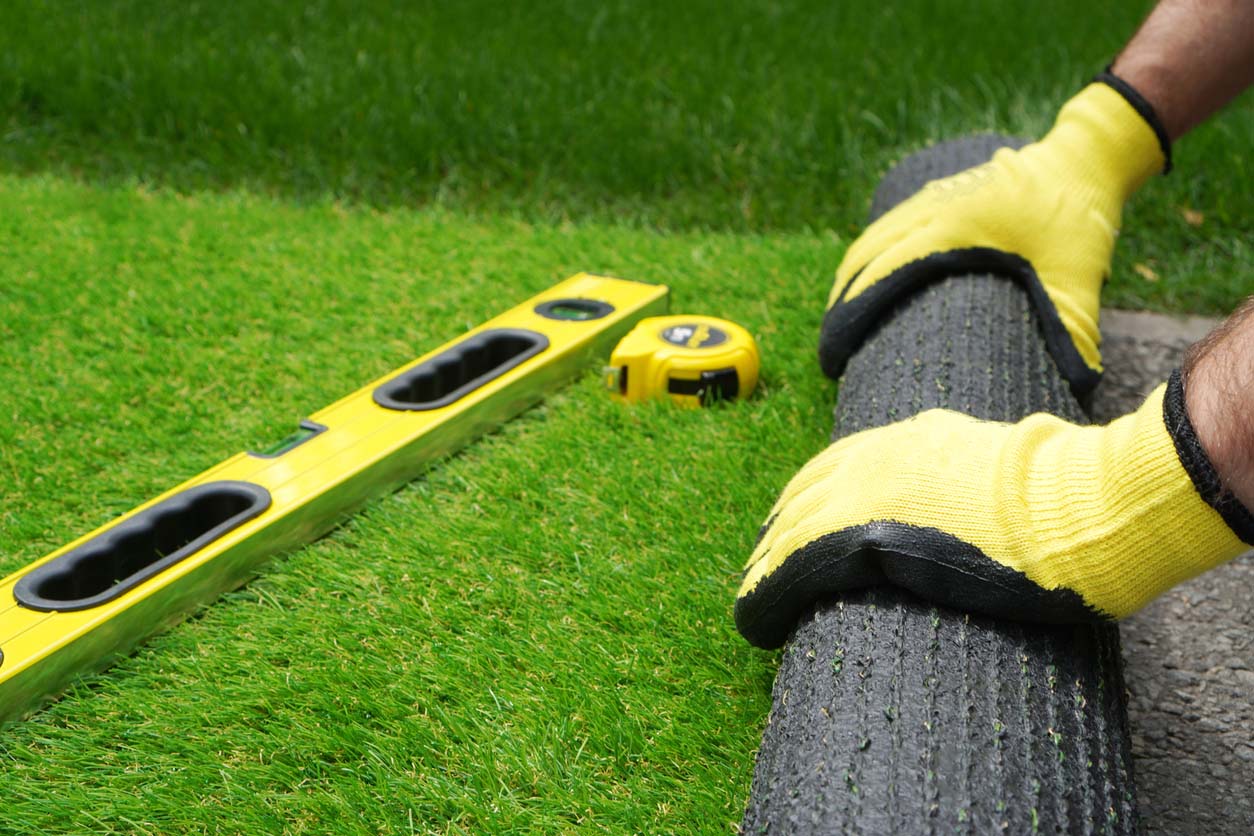
Benefits of Choosing Artificial Grass
For homeowners who love the look of a natural lawn but want to save time and money on maintenance, an artificial lawn has many benefits.
Pest, Weed, and Disease Resistance
With the use of a weed barrier, an artificial lawn doesn’t need fertilizer, insecticides, or chemical treatments for diseases. Homeowners can save money when they don’t need to purchase additional treatments for their lawn, and they’ll never have to worry about having dead grass. Natural grass also provides a comfortable home to insects, snakes, gophers, and more. Pets are safer on an artificial lawn since fleas and ticks are not attracted to the faux grass.
Since natural lawns are prone to diseases, they require a lot of time, money, and effort to treat the grass and prevent problems. Depending on geographic location and climate, some lawns are more susceptible to certain types of diseases than others. They may require fungicides to maintain the health of the lawn, which results in additional costs over the years. Not to mention, fungicides can be harmful to bees. An artificial grass lawn will continue to look great with minimal maintenance.
Drought Resistance
Homeowners in areas that are prone to drought conditions often opt for artificial grass. Homeowners with artificial turf will never suffer from a drought- or heat-stressed lawn. They can avoid water restriction fines from watering a lawn to keep it green and healthy. Maintaining a natural lawn requires copious amounts of water. Since a synthetic lawn doesn’t require watering, homeowners can save money on their water bill, enjoy less water usage, and avoid potential water restriction fines.
In addition, homeowners living in areas with high drought levels may be able to take advantage of rebates and incentives to remove their lawn and conserve water by installing artificial turf instead. For example, the Metropolitan Water District of Southern California has a rebate of $2 per square foot of grass (up to 5,000 square feet) a homeowner replaces with “water-efficient landscaping,” including artificial turf. Similarly, the Southern Nevada Water Authority will pay homeowners $3 per square foot up to 10,000 square feet, and $1.50 per square foot thereafter, to remove their lawn. This can help homeowners cover part of the cost of installing artificial grass while also doing their part for the community.
Sustainability
Many types of artificial grass are made from recycled materials and are themselves recyclable. Along with the time saved from not mowing a lawn, eco-conscious homeowners also benefit from reduced emissions from not running a lawn mower. There is also no need for pesticides, fertilizer, or other chemicals that can harm the environment. Gas-powered lawn equipment produces a significant amount of pollution. By eliminating the use of mowers, blowers, trimmers, and edgers, homeowners can help reduce overall pollution.
Reduced Maintenance
Artificial grass can save time, money, energy, and effort with reduced maintenance. Homeowners with synthetic turf don’t have to buy lawn equipment, pay for treatments to keep a lawn looking healthy and green, or hire the best lawn care services to mow and treat their lawns. Having an artificial lawn can allow homeowners more time to enjoy their backyard for hosting parties, barbecues, and get-togethers rather than spending their time maintaining a natural lawn.
Improved Drainage
Artificial grass often provides superior drainage compared to a conventional lawn. Water is allowed to drain through the turf and into the ground below. For homeowners who live in an arid location, it’s common for lawns to develop puddles and mud after rainfall or after the homeowner waters the grass. Flooding is also a risk, and too much water can destroy a natural lawn. The proper drainage of an artificial lawn can help prevent flooding, puddles, and mud that can be tracked into a house.
Cost-Effectiveness
The comprehensive cost to install fake grass is higher than the cost to install sod, but homeowners can save money over time. The cost-effectiveness is apparent with the savings that come from not having to pay for a lawn mower, lawn equipment, fertilizer, pesticides, or other lawn care costs. Additional savings come from reduced water use and dramatic savings on the water bill. Some drought-prone areas offer payment assistance to install artificial grass to save on water usage. The initial cost of a new lawn is only the beginning when it comes to real grass, but with artificial grass the costs typically end there.
Child-Friendliness
Artificial grass is kid-friendly, unlike weed killer or fertilizer. Children can play on artificial turf without getting grass stains or mud on their clothing and shoes. Some brands of artificial grass even have an antibacterial coating that reduces the spread of bacteria and germs. Kids can play on faux grass without coming into contact with fertilizers, harmful chemicals, or toxic pesticides that are often used on a conventional, natural lawn.
Improved Curb Appeal
A lawn that stays green year-round can improve the curb appeal of a home. With artificial grass, homeowners can enjoy a healthy-looking lawn without worrying about brown patches from drought conditions or extreme temperatures. This home improvement investment can increase the value of a home and will pay for itself over the next several years.
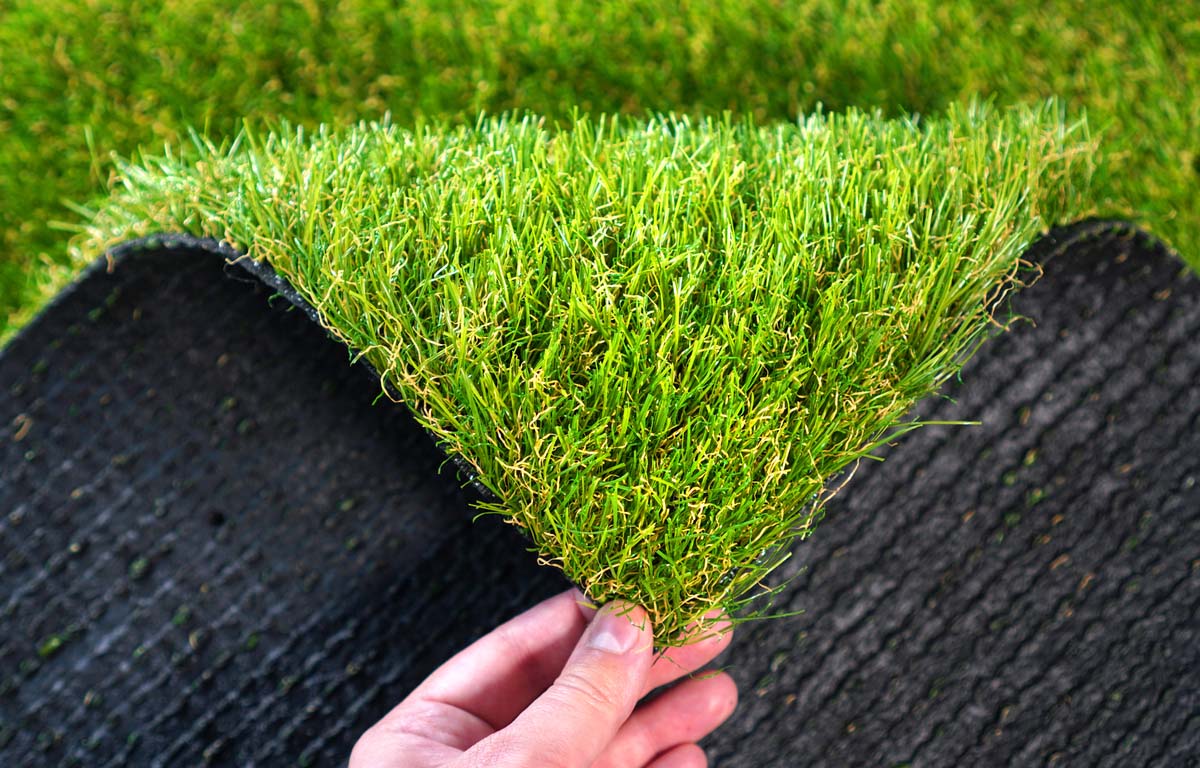
Artificial Grass Installation: DIY vs. Hiring a Professional
Unless homeowners already know how to install artificial grass and have experience, it’s recommended that this project is left to the pros. Incorrect installation can lead to mold and mildew growth from improper drainage. An installation professional has the experience and skills to measure correctly, ensure proper drainage, and make the faux grass look realistic. A professional can also recommend the best artificial grass for the area and provide additional landscaping if needed.
Another consideration is the time it takes to install. What might take a professional team a few days to install could take an inexperienced homeowner weeks of trial and error. Homeowners will want to keep in mind that some artificial grass manufacturers will only warrant their product if it’s installed by a professional.
How to Save Money on Artificial Grass Cost
Budgeting for artificial grass cost can be daunting, especially when using an artificial turf cost calculator and being aware of all the additional costs that are associated with the project. The following are a few ways to save money on artificial grass installation without compromising on quality.
- Get multiple quotes. Get at least three price quotes from reputable artificial grass installers in your area.
- Buy wholesale. Buying fake grass from a wholesale artificial turf supplier can save on product markup from landscapers.
- Do some of the prep yourself. Removing rocks, tree stumps, sticks, leaves, and other debris can save money on labor costs.
- Buy scrap pieces. Artificial grass remnants are typically available at a discounted rate. They are perfect for a small area or project.
- Lower maintenance costs. Installing an artificial lawn will lower the overall maintenance costs since the artificial grass requires significantly less maintenance than a natural lawn.
- Improve lawn durability. Using artificial grass increases the durability of the lawn area and reduces the time and money spent to maintain, reseed, and water a conventional, natural lawn.
Questions to Ask About Artificial Grass Installation
It’s helpful for homeowners to have all the important information regarding artificial grass costs and considerations before deciding on installing a faux lawn. Asking the best sod installation companies the right questions about artificial grass installation can help homeowners avoid miscommunication and find the right artificial grass for the space. The following are some questions for homeowners to ask before deciding on the right pro for the job.
- How much experience do you have with installing artificial grass?
- Will you provide references?
- Do you offer on-site consultations?
- How many artificial grass installations have you done?
- Where can I find examples of your installations?
- How much is fake grass?
- What kinds of artificial grass do you offer?
- What are the different types and sizes of infills that you use?
- How does the artificial turf you provide differ from other artificial lawn products?
- What kind of fake grass do you recommend for my space?
- What is the best type of artificial grass if I have a dog?
- Who will install the artificial grass?
- Do you use your own employees, or do you outsource and use subcontractors?
- What do I need to do to properly maintain my new artificial grass?
- What type of warranties do you offer?
- How can I leave a review at the conclusion of the project?
FAQs
It’s common for homeowners to have a lot of questions about artificial grass. What follows are some common frequently asked questions regarding artificial grass cost to help homeowners find the best professional for the job.
Q. What is the cheapest way to install artificial grass?
Typically, artificial grass installation is done by using seaming glue, seaming tape, and nails. This is the most secure and dependable way of installing an artificial lawn, although it’s also the most expensive way. A cheaper alternative is to just use nails. Artificial grass that’s installed with only nails isn’t as secure since the nails can come loose over time. If the area will not experience heavy foot traffic, using nails to install artificial grass is a money-saving option.
Q. Can dogs pee and poop on artificial grass?
Yes, dogs can pee and poop on an artificial lawn the same way they can on a conventional, natural lawn. Liquids drain through the artificial grass into the ground, although dog owners will need to remove solid waste from the faux grass. Using a hose to remove any waste remnants is highly recommended. Choosing the best artificial grass for dogs comes down to material, density, fade resistance, and drainage.
Q. Is artificial grass worth the cost?
Many homeowners agree that the money they spend on the installation of artificial grass is worth it. Over the long run, they cut their spending on fertilizer, pesticides, water, and maintenance. Having artificial grass reduces puddles, flooding, and mud; decreases water usage; eliminates air pollution; and provides a safe environment for children and pets. Homeowners in wet climates may experience extensive drainage issues, and the installation of artificial grass may not be as beneficial an investment.
Q. What should you put under artificial grass?
To prevent the artificial grass from sinking and to promote proper drainage, a base needs to be installed. The base can consist of crushed rock, gravel, type 1 stone, or decomposed granite. In mild climates, about 3 to 4 inches of a base is needed for proper drainage.
Q. Can you lay artificial grass yourself?
It’s not recommended for a homeowner to install artificial grass on their own unless they have experience with the material. Incorrect measurements and installation can lead to improper drainage, mold and mildew growth, and invalid warranties. An industry professional has the skills, knowledge, and experience to correctly install artificial grass. Hiring a synthetic lawn professional can ensure the material is installed correctly. A professional can also recommend the best type of artificial grass for the home and provide additional landscaping if needed.
Q. Can I pressure-wash artificial grass?
Pressure-washing is an effective way to clean a synthetic lawn that does not have infill. Typically, a quick rinse with a hose after raking is all that’s needed to clean artificial grass, but if it needs a deeper clean, a pressure-washer can be used. Homeowners will want to keep in mind that most artificial lawns have infill to maintain a soft feel underfoot and to prevent wrinkles. For artificial lawns that have infill, using a pressure-washer can remove or move the infill. If the artificial grass does not have infill, homeowners are advised to use a pressure-washer carefully. They’ll want to use a wide-angle tip and keep the tip at least 1 foot from the surface of the faux grass. Additionally, it’s always advised for homeowners to spray at an angle and avoid pointing the tip directly at the ground.
Sources: Angi, HomeAdvisor, HomeGuide

